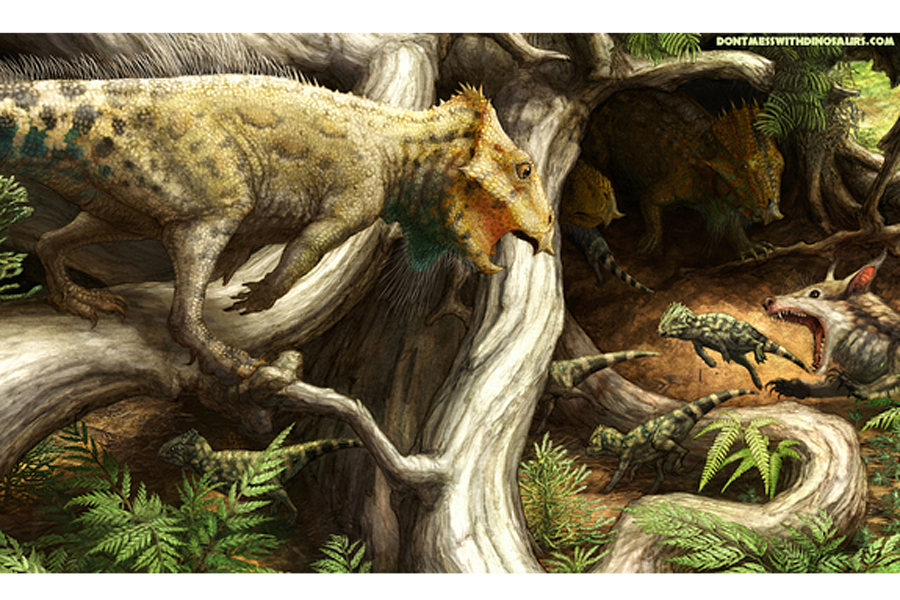Oldest North American horned dino was the size of a crow, say scientists
Triceratops and other horned dinosaurs once thrived in North America, but paleontologists have long wondered how the group originally made it to the continent. Now, an analysis of a small, crow-size horned dinosaur — the oldest horned dinosaur ever found in North America — suggests these dinos migrated from Asia to North America between 113 million and 105 million years ago.
Paleontologists originally uncovered the skull of the horned dinosaur in 1997 — an exciting find, given that until then, scientists had only found a handful of teeth, bones and a tail of early horned North American dinosaurs known as neoceratopsians. The new species, called Aquilops americanus, lived during the Early Cretaceous, about 107 million years ago.
"It's the first complete specimen of a horned dinosaur found in North America from that time," said the study's lead researcher, Andrew Farke, a paleontologist at the Raymond M. Alf Museum of Paleontology in Claremont, California. "And it's even more exciting because it's not at all closely related to later horned dinosaurs from North America." [See photos of the horned dinosaur fossil]
Instead, Aquilops, which means "eagle face" in Latin, is most closely related to animals from Asia, including the dinosaurs Archaeoceratops oshimai and Leptoceratops gracilis.
"In most features, it's virtually identical to them," Farke told Live Science. "And that's cool because it adds support for this idea that, around 110 million years ago or so, there was a big influx of animals from Asia into North America."
At that time, the distance between North America and Asia was slightly farther than it is today, but a land bridge may have connected the two, allowing horned dinosaurs to walk across, said Lindsay Zanno, an assistant research professor of paleontology at North Carolina State University who was not involved in the study.
The tiny skull, measuring just 3.3 inches (8.4 centimeters) long, doesn't have horns like its distant relative, theTriceratops, but has other features unique to horned dinosaurs. For instance, it sports a special toothless beak, called a rostral bone, also seen in turtles and Triceratops.
"It was probably like what you see on birds today," Farke said. "You have a really sharp beak for cropping off vegetation," such as ferns and flowering plants. "If you want to pick and choose what you want to eat, it can be really nice to have a beak that helps bite off those plants."
The rostral bone also has a little bump, which may be the beginning of the type of horn seen in its later relatives, Farke said.
Moreover, the dinosaur had a long, sharply pointed cavity over its cheek region, and cheek spikes. The spikes may have served as ornamentation or as defense, possibly as "a way to inflict pain on a rival, if another animal got too close," Farke said.
A dental examination showed that the dinosaur had about a dozen flat, bladelike teeth that likely sheared off vegetation, as well as peglike teeth that could chomp up plants.
The finding will help paleontologists reconstruct the early evolution of horned dinosaurs, Zanno said.
"Dr. Farke and his team have actually managed to go ahead and name what is essentially the earliest definitive horned dinosaur that we have here on the continent," she said.
The next known horned dinosaur in North America didn't live until about 20 million years after Aquilops, andTriceratops lived about 40 million years later, the researchers said.
Now, when paleontologists study horned dinosaurs, they "can say some definitive things about where things like Triceratops and its ancestors came from," said Michael Ryan, a horned-dinosaur expert at the Cleveland Museum of Natural History who was not involved in the study.
The findings were published today (Dec. 10) in the journal PLOS ONE.
Follow Laura Geggel on Twitter @LauraGeggel. Follow Live Science @livescience, Facebook & Google+. Original article on Live Science.
- Tiny & Old: Images of 'Triceratops' Ancestors
- Album: Animals' Dazzling Headgear
- Paleo-Art: Dinosaurs Come to Life in Stunning Illustrations
Copyright 2014 LiveScience, a TechMediaNetwork company. All rights reserved. This material may not be published, broadcast, rewritten or redistributed.





